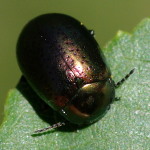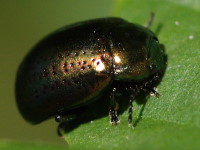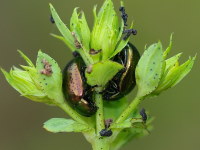Phylum Arthropoda (Arthropods) ➔ Subphylum Hexapoda (Hexapods) ➔ Class Insecta (Insects) ➔ Order Coleoptera (Beetles) ➔ Family Chrysomelidae (Leaf beetles)
Chrysolina (Hypericia) hyperici (Forster, 1771)
Punktierter Johanniskraut-Blattkäfer St John's-wort Leaf Beetle
Synonyms and other combinations:
Chrysomela hyperici Forster, 1771 |
Further vernacular names:
St John's Wort Beetle, St. Johnswort BeetleClassification:
Chrysolina hyperici belongs to the subfamily Chrysomelinae, tribe Doryphorini.Distribution:
Europe east to Central Asia, south to Turkey; introduced in North America and Australia for biological control of St. John's wort on pastures.Habitat:
Sunny ruderal areas, industrial wastelands, along railway lines, pastures - places where St. John's wort grows.Description:
Length 5.0 - 7.0 mm; variable in colour (greenish, brassy, coppery, bluish to black); pronotum and elytra may be of different colours; elytra with very fine basic puncture and with loosely and irregularly arranged rows of larger dots; number of dots in the two outer rows of dots usually not more than 21; upper side of pronotum unclearly dotted, appearing smooth; lateral bulge of pronotum clearly separated at base by a sharp, fine notch, usually dotted at base, length approx. 1/3 to 1/2 of pronotum; claw tarsomer of front tarsi without distinct terminal tooth.Similar species:
A similar species living on St. John's wort is the Klamath Weed Beetle Chrysolina quadrigemina (Suffrian, 1851).Biology:
The St. Johnswort Beetle Chrysolina hyperici lives mainly on common St. John's wort (Hypericum perforatum), significantly less on spotted St. John's wort (Hypericum maculatum), square stemmed St. John's wort (Hypericum tetrapterum) and hairy St. John's wort (Hypericum hirsutum).The imagines are already active at mild temperatures in winter and lay orange-red eggs on the fresh shoots of their host plants. After hatching, the nocturnal larvae live ectophagously on leaves. The larval stage lasts about 40 days. The larvae pupate in the soil at the end of July. After a pupal period of 2 weeks, the new generation hatches. The adults aestivate during summer several weeks and appear again from August.
Natural enemies:
Some species of the tachinid fly genus Macquartia (Diptera: Tachinidae).The ichneumonid wasp Mesochorus giberius (Thunberg, 1822) (Hymenoptera: Ichneumonidae).
References, further reading, links:
- Rheinheimer, Joachim, & Hassler, Michael: Die Blattkäfer Baden-Württembergs, 2018, 928 pages, Kleinsteuber Books (Karlsruhe), ISBN 978-3-9818110-2-5
- Arved Lompe: Die Käfer Europas - Ein Bestimmungswerk im Internet
- Agelastica alni
- Altica sp.
- Aphthona nonstriata
- Bromius obscurus
- Bruchus rufimanus
- Bruchus sp.
- Cassida nebulosa
- Cassida rubiginosa
- Cassida sp.
- Cassida stigmatica
- Cassida vibex
- Cassida vibex/bergeali
- Cassida viridis
- Chrysolina fastuosa
- Chrysolina haemoptera
- Chrysolina hyperici
- Chrysolina lucidicollis
- Chrysolina oricalcia
- Chrysolina sp.
- Chrysolina sturmi
- Chrysolina varians
- Chrysomela populi
- Chrysomela tremula
- Chrysomela vigintipunctata
- Clytra laeviuscula
- Clytra quadripunctata
- Coptocephala sp.
- Crepidodera aurata
- Crepidodera aurea
- Crepidodera fulvicornis
- Crioceris duodecimpunctata
- Cryptocephalinae sp.
- Cryptocephalus moraei
- Cryptocephalus nitidus
- Cryptocephalus pusillus
- Cryptocephalus sp.
- Donacia bicolora
- Donacia cinerea
- Donacia marginata
- Donacia versicolorea
- Galeruca tanaceti
- Galerucella s.l.
- Gastrophysa viridula
- Gonioctena decemnotata
- Gonioctena quinquepunctata
- Gonioctena quinquepunctata/intermedia
- Gonioctena sp.
- Gonioctena viminalis
- Lema cyanella
- Leptinotarsa decemlineata
- Lilioceris lilii
- Lochmaea caprea
- Neocrepidodera ferruginea
- Neocrepidodera sp.
- Oulema melanopus/duftschmidi
- Oulema obscura
- Pachybrachis sp.
- Phratora sp.
- Phratora vitellinae
- Phyllobrotica quadrimaculata
- Phyllotreta armoraciae
- Phyllotreta nemorum
- Phyllotreta vittula
- Plagiodera versicolora
- Plagiosterna aenea
- Plateumaris sp.
- Podagrica fuscicornis
- Psylliodes sp.
- Pyrrhalta viburni
- Sphaeroderma sp.
- Xanthogaleruca luteola


